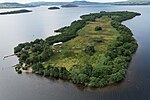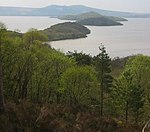Loch Lomond National Nature Reserve (NNR) (Scottish Gaelic: Tèarmann Nàdair Nàiseanta Loch Laomainn) encompasses 430 hectares of land at the southeastern part of Loch Lomond in the council areas of Stirling and West Dunbartonshire, in Scotland. It covers the islands of Inchcailloch, Clairinsh, Torrinch, Creinch and Aber Isle, alongside areas of woodland and wetlands to either side of the mouth of the Endrick Water. NatureScot owns two parts of the reserve - the island of Inchcailloch and part of Gartfairn Wood - and the rest is privately owned. The reserve is managed by a partnership consisting of NatureScot, the RSPB Scotland and the Loch Lomond and The Trossachs National Park, along with the owners and tenants of the land under agreements. Within this framework NatureScot directly manage the islands of Clairinsh, Inchcailloch, Torrinch and Creinch, and land to the north of the Endrick Water. The RSPB manages the area to the south of the Endrick Water, and the national park manages visitor facilities on Inchcailloch.The first part of Loch Lomond to be declared a national nature reserve was Clairinsh in 1958; the reserve was subsequently extended three times to reach its present size. The reserve encompasses a wide range of habitats, including woodlands, open water, grassland and wetlands. Due to its position on the Highland Boundary Fault, the varying natural environments of the highlands and lowlands give rise to habitats and species at both their northern and southern limit. Prior to becoming an NNR, the land was used for farming, producing woodland and to a lesser degree, for recreation. Some of these practices are still used, but now with a stronger focus on wildlife practices and maintaining the diversity of the area.










